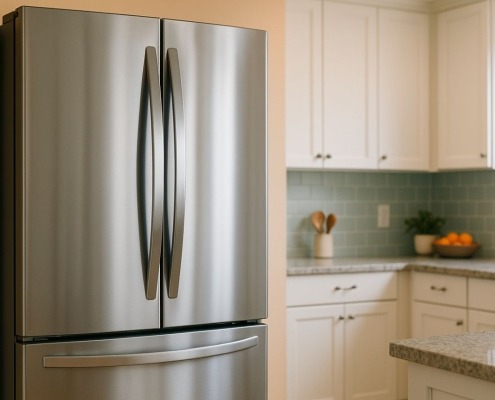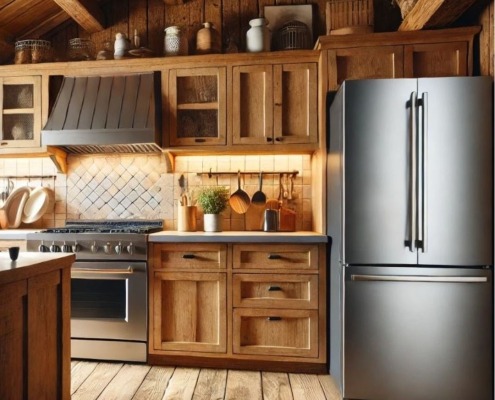Should You Use a Hard Start Kit on Your Fridge?
Steven E / Monday April 21, 2025
When it comes to your trusty refrigerator or freezer, we all want to make sure that its compressor stays in tip-top shape, right? Sometimes, though, the compressor needs a little extra kick to get things going smoothly.
We’ll cover the benefits and things to consider when using a hard start kit. Plus, we’ll walk you through the installation process. We’ve got your back, and we’re here to help you save money on costly repairs while keeping your refrigerator or freezer running smoothly. Let’s dive in and get that compressor running!
You can find a replacement hard start kit for compressors sizes 1/4 through 1/3 HP here. If you need other replacement parts for your refrigerator, just enter your model number at AppliancePartsPros.com to find them. It’s that easy! Most orders arrive in just two business days, and we have thousands of guides to show you how to install your new parts.
The information in this article may not apply to your specific appliance model. We recommend consulting your manufacturer’s documentation or contact us with any questions.
What is a refrigerator hard start kit?
A hard start is a universal device compatible with most models that aids the compressor in starting up your refrigerator. It typically consists of three or four components in one, depending on the part:
Start capacitor: This provides an extra boost of electricity to the compressor during startup, overcoming its initial inertia and getting it running smoothly.
Relay: This acts as a switch, activating the start capacitor only during the initial startup phase and then disconnecting it once the compressor reaches operating speed.
Overload protector: This safeguards the compressor against overheating by cutting off power if it detects excessive current draw.
Run capacitor: On some models this provides an extra power boost to the compressor motor during startup, improving energy efficiency and prolonging the compressor motor’s lifespan.
Why your refrigerator might need a hard start kit
Using a refrigerator hard start kit, which is designed to give the compressor an extra boost during startup, should be approached with caution for several reasons. Primarily, it may lead to more significant problems down the line. These kits can increase the wear and tear on the compressor by subjecting it to higher starting currents, potentially shortening its lifespan.
Hard start kits are often used as a temporary fix rather than addressing the root cause of starting problems, such as electrical supply issues, a bad compressor accessory part or a failing compressor. Additionally, if not selected or installed correctly, they can cause compatibility issues, leading to operational inefficiencies or even damage to the refrigerator’s electrical system.
Therefore, it’s best to replace any bad compressor parts with an OEM replacement and use a universal hard start kit as a temporary solution to keep the refrigerator running until parts can be replaced.
Can a hard start be used on a failed compressor?
Using a hard start kit on a failed compressor is generally not recommended and often ineffective. A hard start kit is designed to help compressors that struggle to start due to weak capacitors or slight overloads by providing an extra surge of power. However, if a compressor has failed—meaning it’s mechanically seized, electrically open, or has suffered other critical failures—no amount of extra starting power will revive it. In such cases, the underlying issues causing the compressor to fail will need to be addressed, which typically involves repairing or replacing the compressor. Attempting to use a hard start kit on a failed compressor can result in further damage to the refrigerator’s electrical system, increased energy consumption, and potential safety hazards.
Tools
- Replacement kit (Choose the correct type of kit for your model)
- Screwdriver
- Wire cutters/strippers
- Electrical tape
Safety precautions
When working on any appliance, remember to keep safety first. Here are some tips to keep in mind:
- Always power off and unplug your appliance or switch off the circuit breaker before attempting any maintenance or replacement work. This keeps you safe by preventing any risk of injury from electric shock.
- Turn off the water supply at the outlet before beginning repairs to any appliance parts that hold water. Have towels ready for any residual water in the system when removing parts.
- Wear insulated work gloves to protect your hands from sharp metal parts, pinching hazards and debris.
- Don’t test wiring with a multimeter for live voltage if you’re unfamiliar with how to prevent short circuiting when testing.
- When working with wires, avoid touching any exposed wires or terminals. If you need to touch a wire, use a non-conductive tool or wear insulating gloves to prevent electrical shock.
- Take your time and don’t rush while working to prevent accidents and personal injuries.
- Work in a well-lit area so you can clearly see and access the interior parts.
- Clear your workspace of clutter and other obstacles. Keep children and pets away from the work area.
- Never work on internal parts with bare wet hands. Make sure the work area is completely dry.
- Check your user manual to see if there are specific installation or safety instructions for your part or appliance.
- Be gentle when handling or removing parts. Excessive force might damage the appliance or cause injury.
- Wear safety glasses when working with chemicals, dust or cleaning large debris to prevent injury.
- If the appliance has recently been used, give it plenty of time for any heating parts to cool down before working on it.
- Take pictures or make a note of wiring terminals or other connections before disconnecting to prevent any problems with reassembly.
How to install a kit
- Before beginning the installation, unplug the refrigerator from the power source.
- The compressor is typically located at the back of the refrigerator, behind a panel. Remove the panel to access the compressor.
- Look for the start relay attached to the side of the compressor. It is a small rectangular or cylindrical component with wires connected to it.
- Carefully disconnect the power wires from the start relay. Take note of their positions or take a picture to ensure proper reconnection later.
- Unscrew or unclip the start relay from the compressor. Gently pull it away, making sure not to damage any wires.
- Take the universal hard start kit and identify the corresponding connection points. It should have three terminals labeled “S,” “R,” and “C.” Refer to the instructions provided with the kit for specific details.
- Connect the wires from the refrigerator to the corresponding terminals on the universal hard start kit. The wires may need to be stripped to expose the bare ends before connecting. Use wire connectors or electrical tape to secure the connections.
- Once the wires are securely connected, mount the universal hard start kit in a suitable location near the compressor. Make sure it is positioned securely and won’t interfere with any moving parts.
- Use zip ties or clips to secure the wiring, keeping it neat and away from any potential hazards.
- Reattach the panel covering the compressor and any other parts you removed during the installation.
- Plug in the refrigerator and turn on the power. Listen for any unusual noises or vibrations indicating a problem.
Additional information
Thanks for reading! If you have any other appliance repair needs or projects, you can find more resources including our DIY blog at AppliancePartsPros.com. There, you can enter your model number to order the exact parts you need. Most orders arrive in two business days.
You can also reach our award-winning customer service team at 1-877-477-7278, chat with a pro on our website and watch thousands of free video tutorials on our YouTube channel.
With nearly a decade of experience in providing top-notch customer service regarding appliance parts and repair, Steven enjoys sharing practical advice, troubleshooting tips, and interesting information to help readers stay informed.





